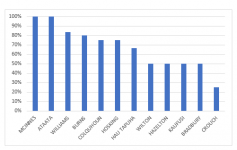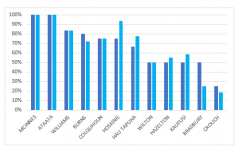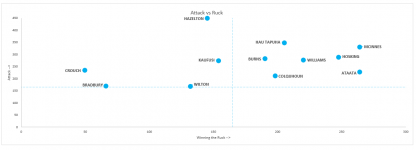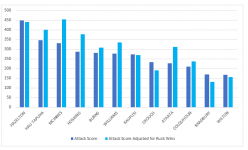OK - so I just re-watched all of the forward runs from the weekend (wasn't much work because they had hardly any ball).
If we look at the % of time a player won the tackle we get this...

This doesn't account for situation though.
Say a "baseline" stint looks like this..
- 4 runs into 2 man tackles (win 3, lose 1)
- 4 runs into 3+ man tackles (win 2, lose 2)
A model should reflect that a player's rating goes
up if more than 50% of his runs were into 3-man tackles, and
down if more than 50% of his runs were 1 or 2 man tackles.
If we run these same numbers accounting for that, we get something like this...
Our baseline player discussed above would score 62.5% here, and the team average was ~67%.

If we then convert that number into something that scales nicely against the involvement model (baseline score = 165) we can get the closest thing we've seen yet to "involvement vs oopmh".
Keep in mind that in a trial game we are not accounting for opposition quality here. Kaufusi and Hazelton were running at the Saifiti twins while some of those young players were running at 19yo kids. The purpose of working through this in a trial is to refine the model. Not to point out who was playing better.

If we wanted to incorporate this into the greater model, we could look adjusting attacking scores based on how well they performed against the team average (62.5%).
- Slight fall for Kaufusi and Hazelton
- Big jumps for the 4 guys who won the ruck at a high rate
- Big drops for a couple of the young guys
Et viola .. we now have an attacking comparison graph which incorporates run location, errors, offloads, and ruck wins. A player who consistently wins the ruck is much more valuable than just what his metres or runs stats can reflect.





